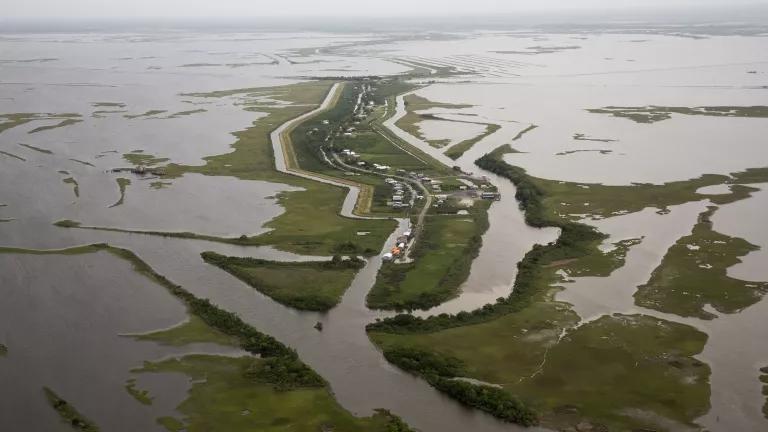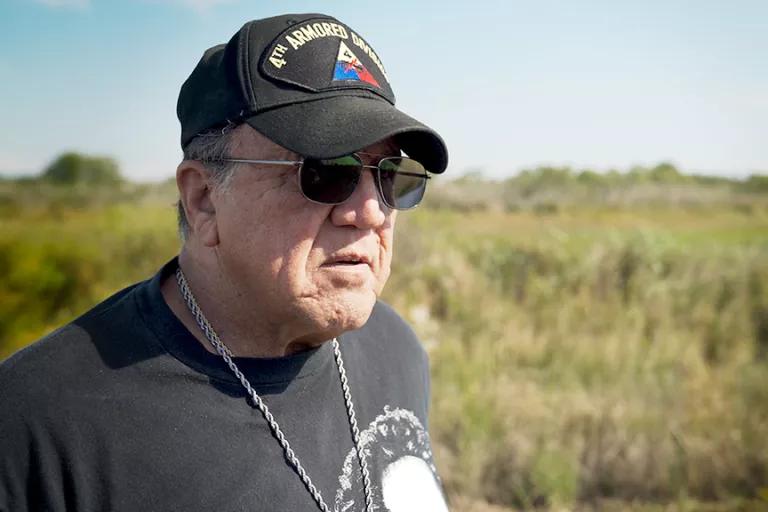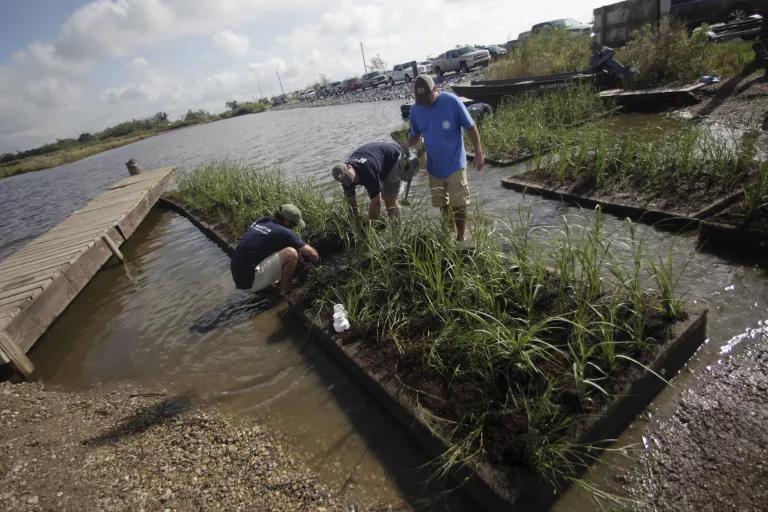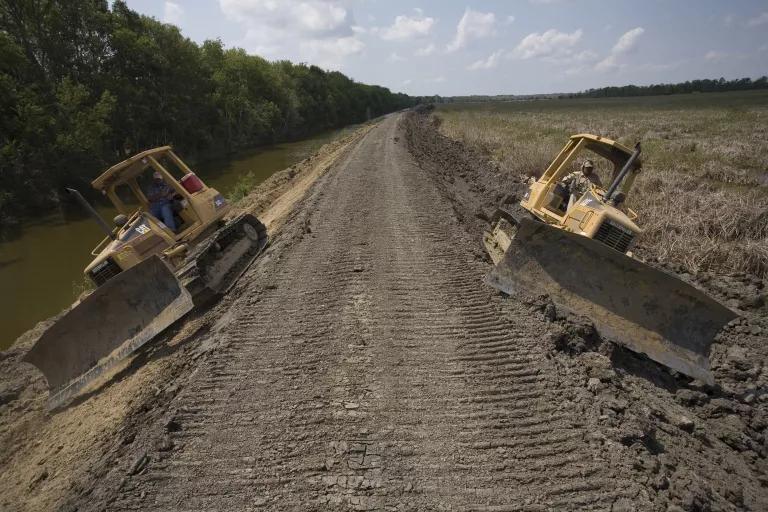The People of the Isle de Jean Charles Are Louisiana’s First Climate Refugees—but They Won’t Be the Last
Whether and how to uproot communities are difficult and painful questions, and we need to get better at answering them.

Isle de Charles, Louisiana
Carolyn Van Houten/National Geographic
The Louisiana coast looks like a lace doily, with its thin filigrees of land disappearing into inlets of marshy seawater. The state’s outline didn’t always appear so delicate, but its coastal threads are becoming more sparse. The Bayou State loses about a football field’s worth of land to erosion about every hour and a half. Since 1955, the Isle de Jean Charles, a sliver of island 80 miles southwest of New Orleans, has shrunk by 98 percent. At a mere quarter mile across by two miles long, the isle continues to slip into the Gulf of Mexico, making living here increasingly difficult.
Life on the Isle de Jean Charles is pared down. The community currently consists of just a cluster of wooden homes, a fire station, and a small boat dock. The church is gone. So is the grocery store. And the only road connecting the island to the mainland floods frequently, limiting access to work and school.
Most of the residents belong to the Isle de Jean Charles (IDJC) Biloxi-Chitimacha-Choctaw tribe. In the 1830s, the grimly titled Indian Removal Act, which forced American Indians to migrate west of the Mississippi, relocated the tribe here from Louisiana’s mainland. At the community’s peak, 300 families called Isle de Jean Charles home, but only about 26 remain. Erosion fueled by a mix of climate change and land subsidence accelerated by the fossil fuel industry is forcing them out once more.
“Our families are moving off,” says IDJC chief Albert Naquin, who lived there until 1974, when Hurricane Carmen flooded his home. “One family moves here, and another family moves there. And you start not knowing people,” the chief says. “It’s very sad, I can tell you that.”

Chief Albert Naquin of the Isle de Jean Charles Biloxi-Chitimacha-Choctaw tribe
Nicky Milne/Thomson Reuters Foundation
After the community spent years beseeching the state to reunite the tribe on higher, drier land, the Louisiana Office of Community Development (OCD) won a grant in 2016 with $48 million reserved for the tribe’s resettlement. The people of Isle de Jean Charles are Louisiana’s first climate refugees, but they will not be the last. The state’s climate forecast predicts sea levels rising between 1.41 and 2.72 feet by 2067, which would place more than 1.2 million people at risk of coastal flooding. The frequency and severity of hurricanes and extreme rainfall are also expected to increase.
Lying at the heart of the IDJC tribe’s logistical and emotional quandary is the question of how Louisiana can guarantee that the communities most affected by climate change have a voice and a choice in the decisions driving their futures.
The names of natural disasters roll off Louisianans’ tongues: Hurricanes Katrina, Rita, Gustav, Ike, Isaac (to name just a few recent ones). But not all major flooding events earn official monikers. In August 2016, a staggering 20 inches of rain poured over southern Louisiana, inundating more than 109,000 homes and disrupting 20 percent of businesses across the state. The frequency of such events has kept Louisiana in a near-perpetual state of recovery, but it has also sent a clear message that long-term planning for climate resiliency is essential, not optional. Two possible outcomes exist, says Mathew Sanders, OCD’s resilience program manager. Either change will be achieved through thoughtful and equitable planning, or there will be an ongoing cycle of disaster and recovery.
For Louisiana, preparing for a future in which intensified sea level rise, land loss, and storms are the new normal requires, at minimum, a two-track approach—one focusing on the land itself, the other on its people. In 2017, the state began work on its Coastal Master Plan, a 50-year blueprint that aims to build land by reestablishing the Mississippi River’s natural flow of sediment to wetlands and to minimize flooding through vast engineering projects, such as levees. The plan addresses the land’s role in buffering communities, but more focus is needed on the communities themselves.
The discussions taking place around displacement and resettlement are in their fledgling stage in Louisiana, and though far from perfect, they need to keep happening, says Al Huang, an NRDC attorney who focuses on environmental justice. The homes in jeopardy belong all too frequently to rural, low-income families of color, and the IDJC crisis is the state’s first attempt at reconciling such climate injustices.
“It hasn’t been an easy conversation on Isle de Jean Charles,” says Sanders. “There are acute consequences for people living the experience on a daily basis, and we need a real high degree of empathy for those going through it.”


From top: Workers connect floating mats made from recycled material, with marsh grass planted on them, designed to take root and build new marshland on Isle de Jean Charles; bulldozers building a hurricane protection levee in Terrebonne Parish.
From top: Gerald Herbert/AP; Tyrone Turner/National Geographic
Community buy-in is, of course, vital. This is why the OCD, together with the Foundation for Louisiana, a racial justice organization, developed a new climate adaptation plan this past April. Called LA SAFE (Louisiana’s Strategic Adaptations for Future Environments), the plan is designed to be community driven as residents face the hard truth.“Conditions are likely to get worse before they get better,” Sanders says. “For some, relocation will be the only viable option.”
For what’s expected to be a yearlong process, 2,835 coastal residents attended 71 LA SAFE meetings across the six coastal parishes that Hurricane Isaac hit the hardest back in 2012. “It was the first time someone came into my community and said it wouldn’t be OK,” says Terrebonne Parish resident Jonathan Foret, the executive director of the South Louisiana Wetlands Discovery Center. Attendees viewed maps projecting sea level rise in their communities to spur discussions about climate resilience and impacts they are already seeing, including higher insurance costs and lower property values, which can lead to less tax revenue and more limited community services.
After five rounds of discussions, the communities came together to recommend a number of initiatives for the OCD to invest in. Ten projects are already moving forward. In Terrebonne Parish, there’s a voluntary buyout program to move residents out of areas deemed “high risk” to higher, drier, and safer land. In Jefferson Parish, a multipurpose facility for environmental education is in the works. And Plaquemines Parish—famed for commercial and recreational fishing—is planning to build a safe harbor for boats during disasters.
“It was extraordinary to see that level of accountability to the public,” says Liz Williams Russell, the coastal community resilience director for Foundation for Louisiana. She says previously it had been unclear whether the residents’ project selections would be given priority.
Meanwhile, back on Isle de Jean Charles, resettlement continues to move forward. In January, the Louisiana Land Trust, on behalf of the state, bought a 515-acre tract of farmland in Terrebonne Parish to be the site of the new community. Construction begins next year, and current isle residents and those who fled after Hurricane Isaac have first dibs on housing options.
But as anticipated, uprooting a community is not so simple. While most families on the island have shown interest in moving to the new location, six would prefer to stay put, citing old age and deep attachment to the island. Chief Naquin won’t be moving to the new settlement either. He says the state’s plans for the community have lost their original intent of allowing the tribe to be in charge of the sustainable vision for their new home. Meanwhile, the government maintains the goal has always been the same: to provide safe harbor for all island residents.
The tribe’s trust in the government has frayed much over the past 200 years, and rightly so. Now the path forward for Louisiana and the IDJC must be handled as delicately as the land they stand on.
This NRDC.org story is available for online republication by news media outlets or nonprofits under these conditions: The writer(s) must be credited with a byline; you must note prominently that the story was originally published by NRDC.org and link to the original; the story cannot be edited (beyond simple things such as grammar); you can’t resell the story in any form or grant republishing rights to other outlets; you can’t republish our material wholesale or automatically—you need to select stories individually; you can’t republish the photos or graphics on our site without specific permission; you should drop us a note to let us know when you’ve used one of our stories.

Mutual Aid and Disaster Justice: “We Keep Us Safe”
Katrina, Climate, and Justice: A Future in Foreshadow?
Defender of Housing Justice